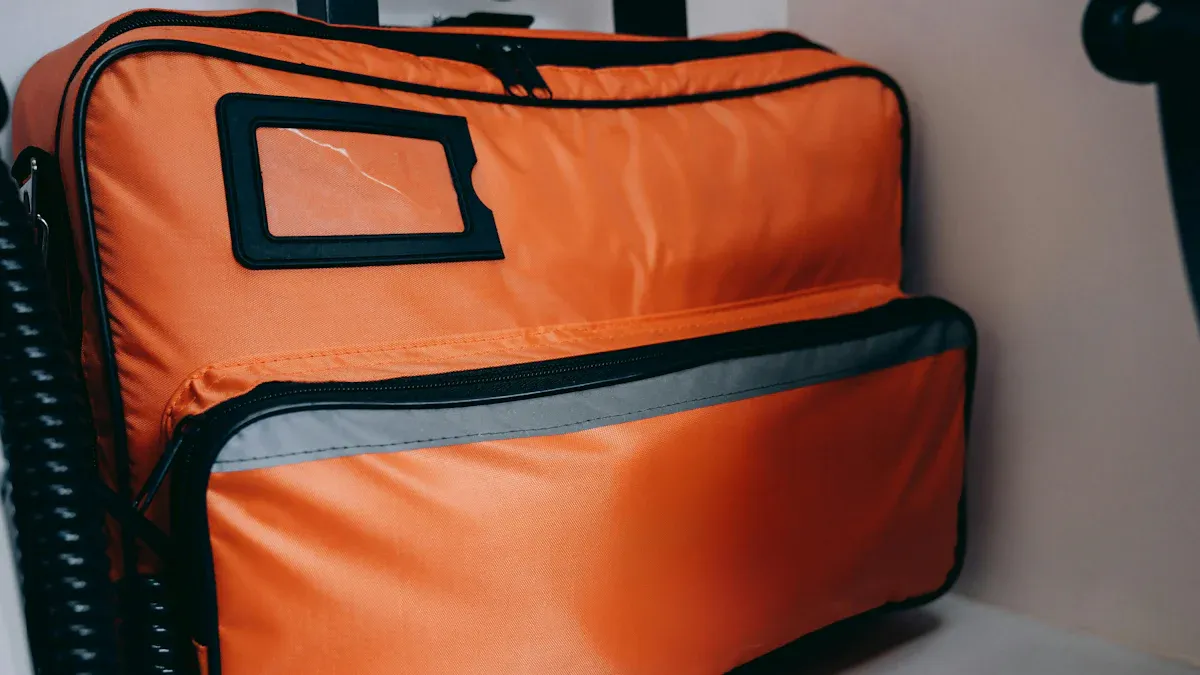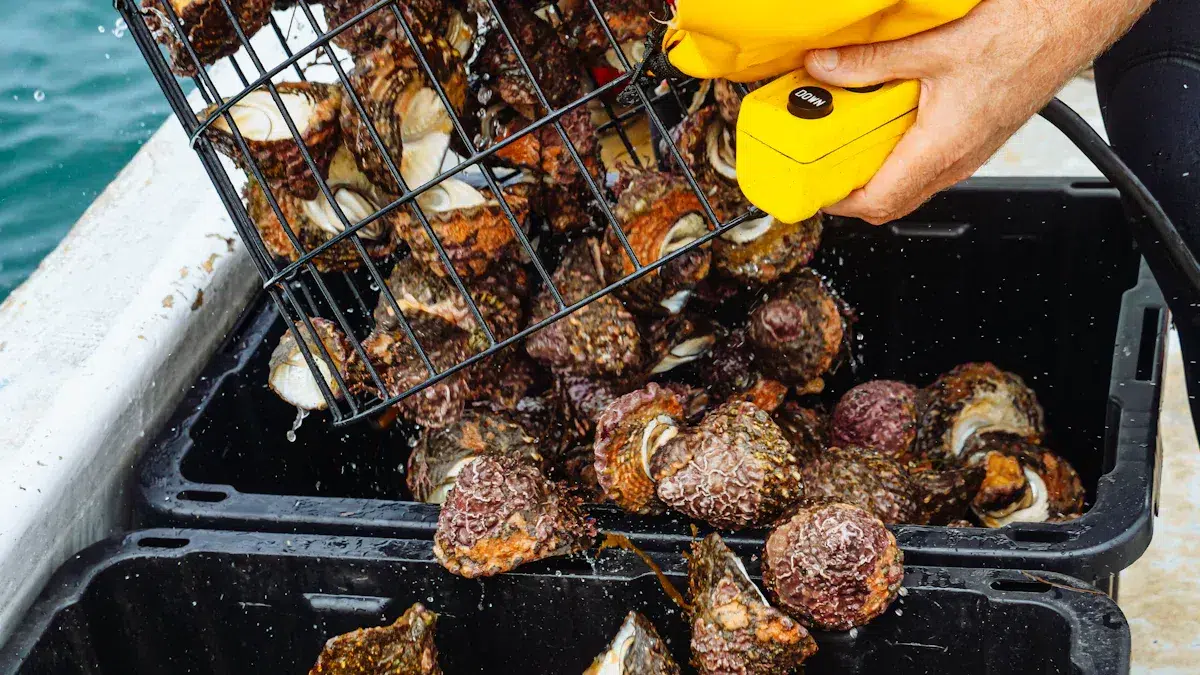
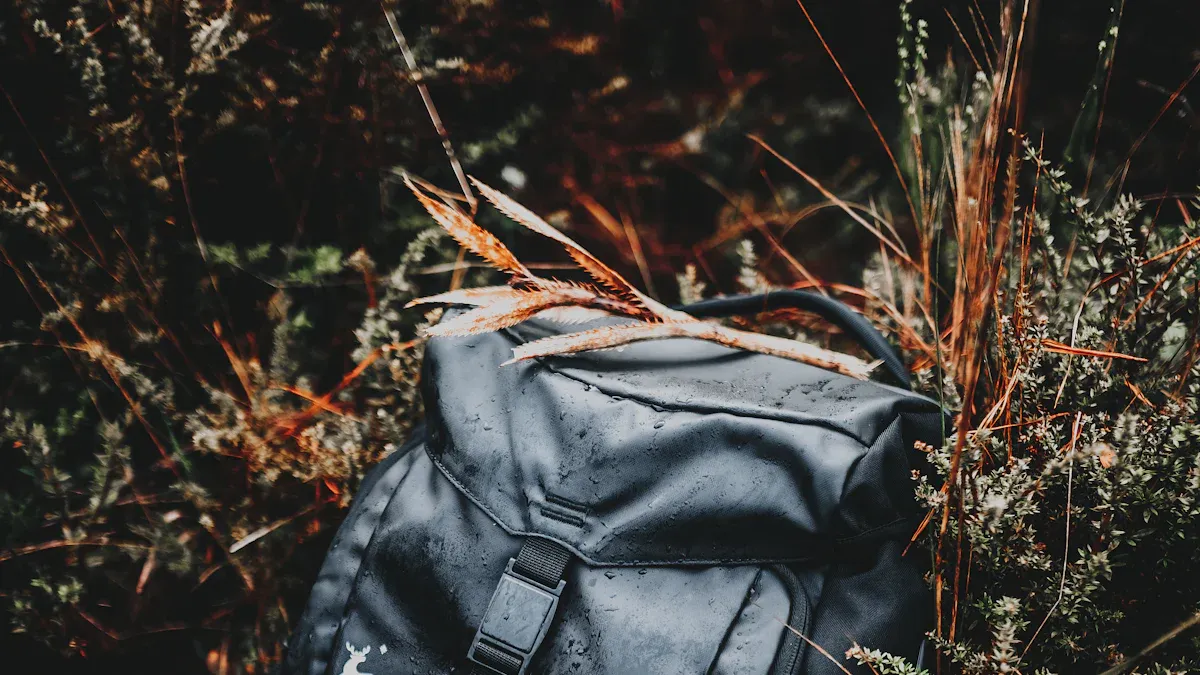
When you head into extreme outdoor adventures, you want your food and drinks to stay fresh and cold. A strong bags cooler gives you the toughness and insulation you need. Look for features like thick walls, sturdy zippers, and water resistance. If you pick the wrong cooler, your supplies could spoil or leak, making your trip stressful. Choose wisely to keep your gear safe and your journey smooth.
Key Takeaways
- Choose cooler bags made from strong materials like reinforced nylon or waterproof polyester. These materials resist wear and tear, ensuring your cooler lasts through tough adventures.
- Look for high-quality insulation features. Bags with thick foam or multiple layers keep your food and drinks cold for longer, making your outdoor experience more enjoyable.
- Ensure your cooler has waterproof and leak-proof designs. Check for sealed seams and waterproof zippers to protect your supplies from rain and spills.
- Select bags with secure closures and heavy-duty zippers. These features keep your items safe and help maintain the temperature inside the cooler.
- Prioritize easy cleaning and maintenance. Regularly wipe down your cooler and check for damage to extend its life and keep it ready for your next adventure.
What Defines a Strong Bags Cooler for Outdoor Use?
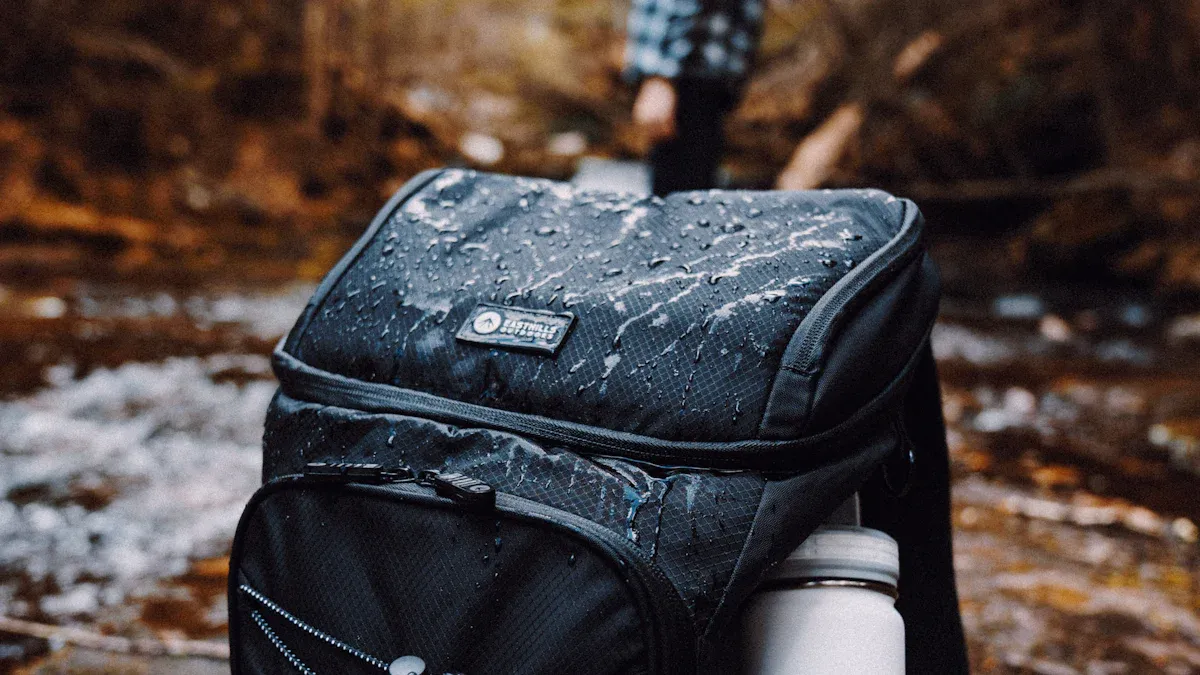
Material Strength and Durability
When you pick cooler bags for tough adventures, you want them to last. You need strong materials that can handle rough ground, sharp rocks, and heavy loads. Reinforced nylon and waterproof polyester stand out. These materials resist tears and keep your bag looking new. Military-grade tarpaulin and heavy-duty marine canvas also offer great durability. They fight off stains, UV rays, and water. Take a look at this table to compare some top options:
| Material | Strength and Durability Features |
|---|---|
| Reinforced Nylon | Withstands wear and tear, ideal for outdoor use. |
| Waterproof Polyester | Resistant to moisture, enhancing durability. |
| Military-grade Tarpaulin | Extremely tough, designed for heavy-duty applications. |
| Heavy-duty Marine Canvas | Resistant to stains, tears, and UV rays, ensuring longevity. |
You want a durable insulated bag that can handle bumps and drops. If you see a marine canvas bottom, you get extra grip and protection. Nylon and polyester are lightweight, so you can carry your cooler bags without feeling weighed down.
Tip: Always check the seams and zippers before you head out. If you spot damage, fix it early to keep your bag strong.
Insulation Quality in Durable Insulated Bags
Insulation quality matters when you want your food and drinks to stay cold or hot. Foam, bubble insulation, and reflective materials help keep the temperature steady. You can find insulated bags that hold cold for 4-6 hours and hot for 2-4 hours. Some cooler bags use extra layers to boost insulation. Here’s a quick look at how different insulation materials perform:
| Type of Bag | Insulation Materials Used | Temperature Retention Time |
|---|---|---|
| Insulated Bags | Foam, bubble insulation, reflective materials | Cold: 4-6 hours, Hot: 2-4 hours |
| Thermal Bags | Additional layer of heat-retaining material | Warm: 2-4 hours |
If you want longer retention, some options can keep ice for days. Check out this chart to see how top insulated cooler bags compare:
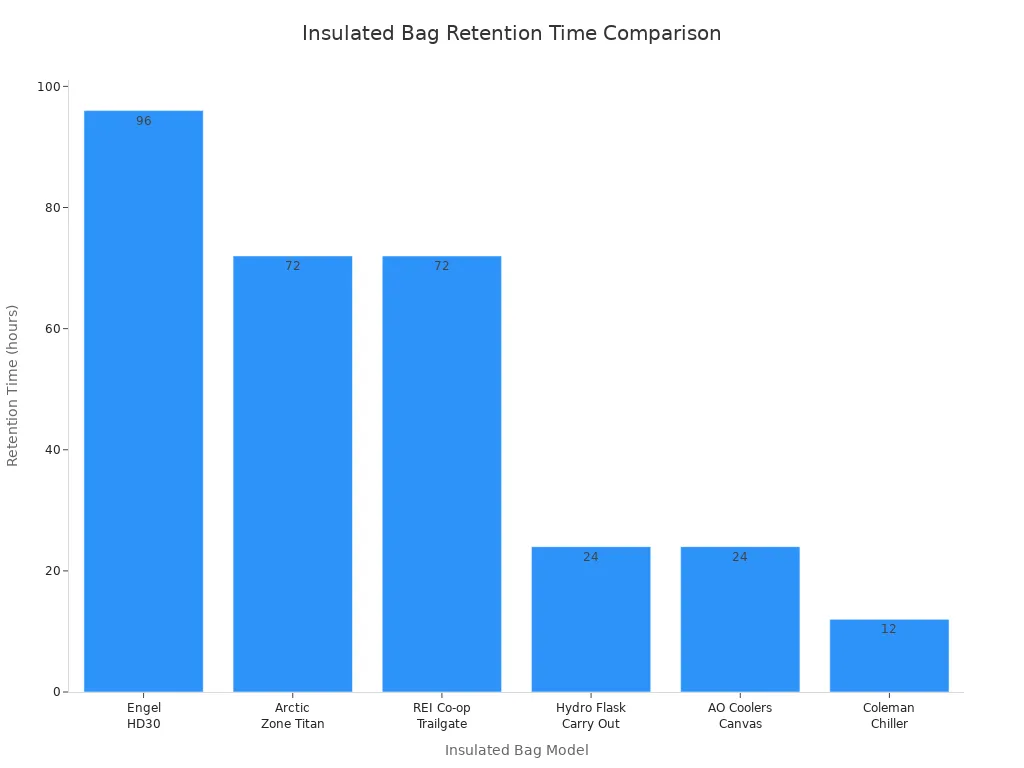
You should look for features like thick insulation and tight seals. These help your cooler bags keep things fresh, even in extreme outdoor conditions.
Weather Resistance for Outdoor Conditions
Weather can change fast when you’re outside. You need cooler bags that stand up to rain, sun, and mud. Waterproof zippers with rubber gaskets keep water out. Roll-top closures create a tight seal, blocking air and moisture. Polyester and nylon are great for resisting water and wear. Canvas gives good insulation but less water resistance.
- Waterproof zippers stop leaks.
- Roll-top closures keep out rain and dust.
- Polyester and nylon fight off moisture and rough use.
You can test your bag’s weather resistance with a simple water test. Seal the bag, pour water over it, and check for leaks. Always inspect zippers and seams before your trip. If you want cooler bags that last, choose ones with strong weatherproof features.
Secure Closures and Heavy-Duty Zippers
When you pack your cooler for a tough outdoor trip, you want to know your food and drinks will stay safe. Secure closures and heavy-duty zippers make a big difference. These features keep everything inside your bag, even if you toss it around or set it down on rough ground.
You might notice that some cooler bags use thick, oversized zippers. These zippers do not break easily. They glide smoothly, even if you have cold hands or wear gloves. Some bags also have double zipper pulls. You can open and close your bag from either side. This makes it easy to grab a snack fast.
Let’s look at what makes a closure strong:
- Heavy-duty zippers: These zippers resist rust and damage. They last longer than regular zippers.
- Waterproof seals: Some zippers have a rubber or plastic coating. This keeps water out, even in heavy rain.
- Strong Velcro or buckles: Some cooler bags use extra straps or Velcro for a tight seal. These help keep the bag closed if you drop it or pack it full.
Tip: Always check the zipper before you leave home. Zip it up and tug gently. If it feels smooth and strong, you are ready for your adventure.
A good closure does more than just keep your bag shut. It helps lock in the cold air. This means your ice lasts longer, and your food stays fresh. If you pick a bag with a weak zipper, you might find leaks or warm drinks by the end of the day.
You want cooler bags that can handle dirt, sand, and water. Heavy-duty zippers and secure closures help you trust your gear, no matter where you go.
Essential Features of Durable Cooler Bags
Heavy-Duty Fabrics and Construction
When you look for cooler bags that last, you want strong fabrics and smart construction. Oxford fabric and polyester stand out as top choices. They feel premium, resist wear, and handle heavy loads. You can wash them many times, and they still look good. Take a look at this table to compare popular materials:
| Material | Key Features |
|---|---|
| Nonwoven fabric | Budget-friendly, easy to customize |
| Oxford / Polyester | Strong, wear-resistant, premium look |
| Cotton | Breathable, eco-conscious |
| Laminated materials | Waterproof, easy to clean |
| Tyvek® | Lightweight, stylish |
| Washable kraft paper | Modern retro look |
You want a durable insulated bag with layers that protect against dirt and moisture. Closed cell foam inside holds cold air and boosts insulation. The outer layer shields your bag from bumps and scrapes. Reflective foil inside helps keep heat out. These features work together to give you durability and great insulation.
Tip: Always check for heavy-duty stitching and sealed seams. These details help your bag survive tough camping trips and outdoor adventures.
Leak-Proof and Waterproof Design
You need cooler bags that keep water out and stop leaks. Leakproof and waterproof features matter when you pack ice or cold drinks. Many insulated bags use PEVA or aluminum foil linings. These linings are food safe, easy to clean, and block leaks. You can trust them to keep your gear dry.
Manufacturers test leakproof claims with hydrostatic pressure testing. They fill the bag with water and press to check for leaks. Real-world usage testing also helps. You use the bag outdoors and watch for leaks over time.
| Testing Method | Description |
|---|---|
| Hydrostatic Pressure Testing | Fill the cooler bag with water and apply pressure to check for leaks. |
| Real-World Usage Testing | Use the bags in practical scenarios to monitor for leaks during actual use. |
Waterproof zippers and sealed stitches add extra protection. You want a bag that keeps water out, even in rain or mud. These options help you enjoy your trip without worrying about spills or wet gear.
Reinforced Handles and Straps for Outdoor Use
You carry cooler bags over rocks, through woods, and across beaches. Reinforced handles and straps make this easy. Strong nylon or polyester straps resist tearing. Heavy-duty components help your bag handle rough outdoor use.
Look for padded handles that feel comfortable in your hand. Double-stitched straps stay strong, even when you pack your bag full. You want features that let you carry your insulated bag with confidence.
- Reinforced stitching keeps straps secure.
- Padded handles reduce strain on your hands.
- Adjustable straps help you carry your bag in different ways.
If you plan a camping trip or a long hike, these features matter. You get durability and comfort, so you can focus on your adventure.
UV and Mold Resistance in Durable Bags
When you spend time outdoors, your gear faces a lot of challenges. Sunlight and moisture can damage your cooler bags if you do not pick the right ones. UV resistance keeps your insulated bags from fading or cracking. Mold resistance stops bad smells and stains from growing inside your bag.
You might wonder why UV resistance matters. The sun’s rays can break down fabric over time. If you leave your cooler bags out in the sun during camping, the material can get weak. UV-resistant coatings protect the fabric and help your bag last longer. You will notice that high-quality insulated bags often use special treatments or fabrics that block UV rays.
Mold is another problem, especially after camping trips. If your bag gets wet and you do not dry it, mold can grow fast. Mold-resistant linings make cleaning easier. These linings stop mold and mildew from sticking to the inside of your bag. You just need to wipe it out and let it air dry.
Here are some tips to keep your cooler bags safe from UV and mold:
- Store your bag in the shade when possible.
- Dry your insulated bag completely after each use.
- Clean spills right away to prevent mold growth.
- Choose bags with UV-resistant and mold-resistant materials.
Note: Mold can ruin your food and make your bag smell bad. Always check your bag before you pack for your next adventure.
If you want your cooler bags to last through many camping trips, look for UV and mold resistance. These features help your insulated bag stay strong, clean, and ready for every outdoor challenge.
Matching Cooler Bags to Outdoor Activities
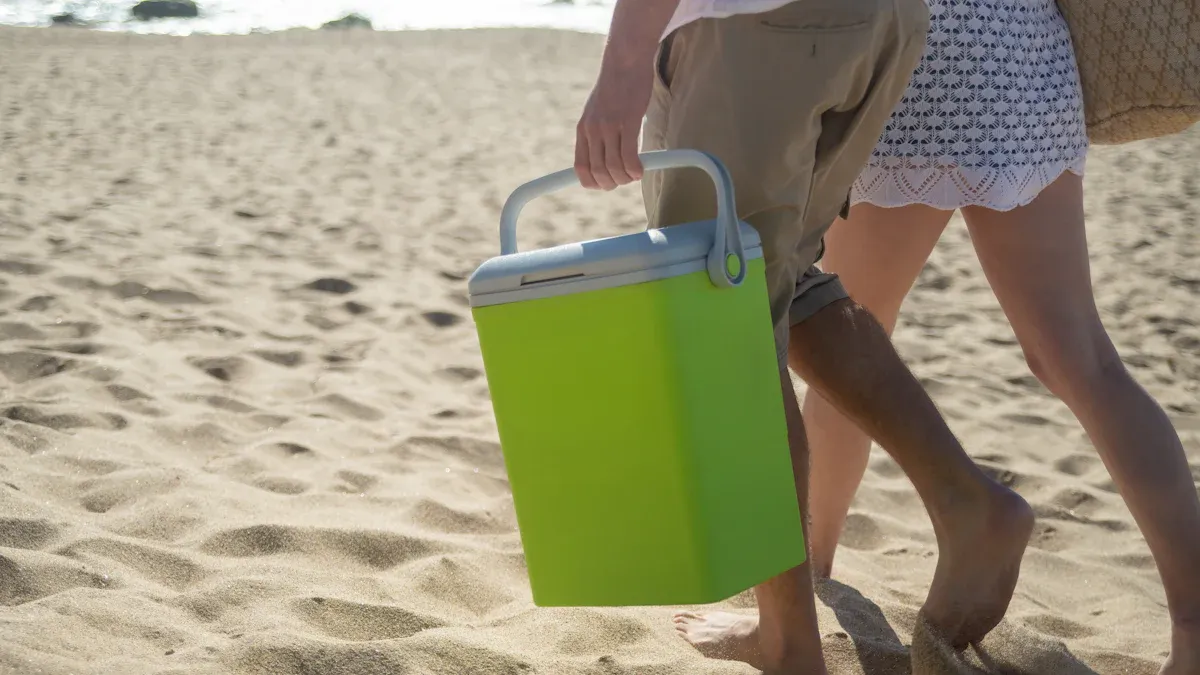
Hiking and Backpacking with Durable Insulated Bags
When you go hiking and day trekking, you want cooler bags that are lightweight and portable. You need insulated bags with strong insulation to keep your snacks and drinks fresh. Look for leakproof linings so nothing spills in your backpack. Choose tough outer fabrics like heavy-duty polyester or nylon. These materials resist wear and are easy to clean after a long day outside.
You will find that adjustable, padded straps make carrying your bag much easier. Backpack-style straps let you keep your hands free for climbing or using trekking poles. Handy pockets give you space for small items like keys or sunscreen. Waterproof coatings help protect your food from sudden rain. Double-stitched seams and strong zippers keep everything secure.
Tip: Pick cooler bags with thick insulation and leakproof features for the best results on your next hike.
Camping and Overlanding Cooler Bags
For camping trips, you need cooler bags that can handle rough outdoor use. Insulated bags with thick foam linings keep your food cold for longer. Leakproof and waterproof designs stop spills from ruining your gear. You want options with reinforced handles and sturdy zippers. These features help your bag survive bumpy rides and busy campsites.
Many campers like bags with extra storage pockets for utensils or snacks. Heavy-duty construction means your cooler bags last through many camping adventures. When you choose the right insulated bag, you can relax and enjoy your camping experience.
Beach and Water Sports Outdoor Cooler Bags
A day at the beach or on the water calls for cooler bags that stand up to sand, sun, and splashes. You want a waterproof and leakproof bag to keep your drinks cold and your food dry. Insulated linings help maintain the right temperature, even under the hot sun. Look for portable options with comfortable straps so you can carry your bag easily across the sand.
Some cooler bags come with UV-resistant coatings to protect against sun damage. Handy pockets let you store sunscreen or sunglasses. With the right features, your cooler bag becomes the perfect companion for any beach or water sports adventure.
Fishing and Hunting with Strong Bags Cooler
When you head out for fishing or hunting, you need a cooler that can handle the wild. You want your catch or game to stay fresh all day. A strong bags cooler gives you the toughness you need for these adventures. It keeps your food, drinks, and even your fish or game cold and safe.
You might face rough terrain, mud, or even rain. Your cooler bags should have a rugged shell and leak-proof lining. This way, you do not have to worry about water getting in or out. Heavy-duty zippers and reinforced handles help you carry your cooler over rocks, through brush, or across a dock. You can toss it in your truck or boat, and it will hold up.
Here are some features you should look for when picking cooler bags for fishing and hunting:
- Thick insulation to keep ice from melting fast
- Waterproof and easy-to-clean lining
- Strong handles for carrying heavy loads
- Pockets for storing tools, bait, or snacks
- UV protection to stop sun damage
Tip: Always pack your cooler with ice packs or block ice. This keeps everything colder for longer and helps your strong bags cooler perform its best.
A table can help you compare what matters most:
| Feature | Why It Matters for Fishing & Hunting |
|---|---|
| Leak-proof lining | Stops water from leaking out or in |
| Heavy-duty zippers | Keeps your catch secure |
| Reinforced handles | Makes carrying easier, even when full |
| UV protection | Prevents sun damage during long trips |
You want to focus on your adventure, not on spoiled food or melted ice. The right cooler bags make your fishing or hunting trip easier and more fun.
Common Mistakes When Choosing Durable Cooler Bags
Overlooking Size and Capacity for Outdoor Needs
You might think bigger is always better, but that’s not true for cooler bags. If you pick a bag that’s too large, it can trap warm air and make ice melt faster. A small bag may be easy to carry, but it might not hold enough food or drinks for your trip. You need to match the size of your cooler bag to your outdoor plans. Ask yourself how many people you’re packing for and how long you’ll be out. If you choose the right size, your items stay cold and fresh.
Tip: Always check the capacity before you buy. A bag that fits your needs will keep your adventure stress-free.
Ignoring Weight and Portability in Durable Bags
Weight matters when you’re hiking, camping, or heading to the beach. Some cooler bags look tough but feel heavy when loaded. If you ignore weight, you might struggle to carry your bag over long distances. Portability is key for outdoor fun. Look for padded straps and handles that make carrying easier. Lightweight materials help you move quickly and stay comfortable. You want a bag that’s strong but doesn’t slow you down.
Here’s a quick table to help you compare:
| Feature | Why It Matters |
|---|---|
| Lightweight | Easier to carry farther |
| Padded straps | More comfort on the go |
| Compact design | Fits in backpacks easily |
Prioritizing Style Over Function in Cooler Bags
It’s easy to get distracted by cool colors or trendy designs. You might see a stylish bag and forget to check if it’s actually durable. Function should always come first. A well-insulated lining keeps your food cold and helps prevent leaks. Strong fabrics and sturdy zippers add to the durability of your cooler bags. Waterproof features protect your supplies from spills and rain. If you focus on style alone, you risk ending up with a bag that looks good but doesn’t perform when you need it most.
Note: Always check the features before you decide. A functional bag will last longer and work better outdoors.
Neglecting Cleaning and Maintenance for Durability
You might think your cooler bags can handle anything, but skipping cleaning and regular care can shorten their life. When you forget to clean your bag after a trip, bacteria and mold can start to grow. This not only makes your bag smell bad, but it can also put your family’s health at risk. No one wants to open a cooler and find a nasty surprise inside!
If you want your cooler bags to last, you need to check them after every adventure. Look for tears, holes, or leaks. Even a small rip can let warm air in and cold air out. That means your food and drinks won’t stay fresh for long. Regular maintenance also protects the insulation foam inside. If the foam gets wet or dirty, it can warp or break down, making your bag less effective.
Here’s what happens when you skip cleaning and care:
- Bacteria and mold build up inside the bag.
- Stubborn stains and bad smells become hard to remove.
- Insulation foam can warp or lose its shape.
- Tears or holes let cold air escape.
- The bag stops working as well and may not last as long.
You can keep your cooler bag in top shape with a few simple steps. Wipe it out after each use. Let it dry completely before storing. Check the seams and zippers for damage. These habits help your bag stay clean and ready for your next trip. With proper care, your cooler bag can stay functional for years.
Tip: Make cleaning your cooler bag part of your routine. It only takes a few minutes, but it makes a big difference!
Expert Tips for Maintaining Durable Insulated Bags
Proper Cleaning and Storage for Outdoor Use
You want your durable insulated bag to last through every adventure. Cleaning it the right way keeps it fresh and strong. Start by emptying out all food, crumbs, and loose debris. Don’t forget to check pockets and zippered compartments. Use a soft cloth with warm soapy water to wipe down the inside. Pay close attention to corners and seams, where dirt likes to hide. If you spot stains or odors, mix baking soda with water to make a paste. Rub it on the spot, let it sit for 15 minutes, then wipe it off. Baking soda helps neutralize smells without harsh chemicals.
Clean the outside with a mild detergent and water. Avoid soaking the bag; a damp cloth works best. Rinse any soap off with a clean wet cloth so nothing sticky stays behind. Open all compartments and let your insulated bag air dry upside down in a well-ventilated spot. Sunlight helps, but don’t leave it out for hours to prevent fading. For regular use, wipe your bag out daily to stop smells from building up. You can place a small sachet of baking soda or activated charcoal inside when not in use to absorb moisture and odors. Always check the insulation seams and lining for damage, since this affects temperature control.
Handling and Transporting Strong Bags Cooler
You want your cooler bag to stay leakproof and durable, even when you’re on the move. Carry your insulated bag by its reinforced handles or padded straps. This helps prevent strain and keeps the bag from tearing. If you pack heavy items, distribute the weight evenly. Don’t overload one side, or you might damage the insulation or seams. When you set your bag down, choose a flat, dry surface. Avoid dragging it over rocks or rough ground. This protects the leakproof lining and keeps the bag looking new. Always close zippers and secure closures before lifting or moving your cooler bag. This keeps everything inside safe and helps maintain insulation.
Repairing vs. Replacing Durable Cooler Bags
Sometimes your durable insulated bag gets a tear or the zipper stops working. You might wonder if you should repair it or buy a new one. Repairing your cooler bag often costs less than replacing it. If your bag is still under warranty, the manufacturer may fix it for free. Some third-party repair shops offer good prices and won’t void your warranty. You can try simple DIY repairs if you have the right skills. Fixing small problems, like patching a leakproof lining or sewing a loose strap, can extend your bag’s life. If the damage is too big or affects insulation, replacing the bag might be the best choice. Regular maintenance helps you avoid major repairs and keeps your cooler bag ready for every trip.
Comparing Cooler Bags Materials for Outdoor Durability
Soft-Sided vs. Hard-Sided Durable Bags
When you pick a cooler bag, you face a choice between soft-sided and hard-sided designs. Soft-sided coolers feel light and easy to carry. You can grab one for a quick day trip or a picnic. These bags work best when you want something portable. Hard-sided coolers stand out for their toughness. You get better ice retention and durability, which helps on longer adventures.
Here’s a quick look at how they compare:
| Feature | Soft-Sided Coolers | Hard-Sided Coolers |
|---|---|---|
| Durability | Less durable, prone to wear and tear | Highly durable, built for harsh conditions |
| Ice Retention | Limited, typically lasts 1-2 days | Excellent, can maintain low temperatures for days |
| Portability | Lightweight and easy to carry | Heavier, less portable |
| Best Use | Day trips, convenience | Extended trips, harsh environments |
- Soft-sided coolers are lightweight and portable, ideal for day trips.
- Hard-sided coolers offer superior durability and ice retention, suitable for extended trips.
If you plan to camp for several days or tackle tough terrain, hard-sided coolers give you peace of mind.
Nylon, Polyester, and TPU in Strong Bags Cooler
You see cooler bags made from nylon, polyester, and TPU. Each material brings something special. Polyester feels light and easy to clean. You can toss it in your car and not worry about stains. Nylon stands out for its toughness and water resistance. You get a bag that stays flexible and strong, even in rough weather.
The advantages of nylon in cold storage bags cannot be ignored. Nylon provides the perfect balance between durability, water resistance, and flexibility. It can remain light in harsh environments and is ideal for outdoor activities. In addition, its versatility in high-density variants, such as those used by high-end brands, ensures that the cooler bag not only performs well, but also lasts longer in harsh conditions.
TPU offers excellent waterproofing and abrasion resistance. You get a bag that handles rain and mud with ease. TPU also supports recycling, which helps the environment.
| Material | Advantages | Disadvantages |
|---|---|---|
| Polyester | Durable, lightweight, easy to maintain, insulation compatibility | N/A |
| Nylon | Tough, water-resistant, easy to clean, lightweight, high-denier fabric | N/A |
| TPU | Excellent tensile strength, abrasion resistance, waterproof, recyclable | Susceptible to UV degradation, not high-temperature resistant, higher cost than PVC |
Insulation Types and Performance in Cooler Bags
Insulation makes a big difference in how long your cooler bag keeps things cold. Polyethylene (PE) foam works well for basic needs. You get moisture protection and a budget-friendly option. EVA foam gives you more cushioning and bounce. It helps your bag stay comfortable to carry and keeps food safe.
Polyurethane (PU) foam stands out for the highest R-value. You get the best temperature retention, which helps on long trips. Metallized PET or aluminum films reflect heat away. These layers cut radiant heat by up to 95%, keeping your drinks colder.
| Insulation Type | R-Value per inch | Density (kg/m³) | Cost (USD/m² @5mm) | Notes |
|---|---|---|---|---|
| Polyethylene (PE) Foam | 1.0–1.4 | 20–40 | $3–$5 | Economical, moisture-proof |
| EVA Foam | 1.2–1.7 | 60–100 | $6–$8 | Higher cushioning, excellent rebound |
| Polyurethane (PU) Foam | 1.6–2.0 | 30–50 | $7–$10 | Highest R-value, water-sensitive |
| Metallized PET/Aluminum | N/A | N/A | N/A | Reflects radiant heat by 90–95% |
If you want your cooler bag to perform in extreme conditions, pay attention to the insulation type. You get better results and longer-lasting cold for your food and drinks.
Budget-Friendly Durable Cooler Bags for Outdoor Activities
Affordable Durable Insulated Bag Brands and Models
You want a cooler bag that lasts but doesn’t break the bank. Many brands offer durable insulated bags at prices you can afford. You might see names like Coleman, Igloo, and Arctic Zone. These brands use tough fabrics and solid insulation. Their cooler bags keep your food cold for hours. You get leakproof linings and sturdy zippers, which help prevent spills. Some models have extra pockets for snacks or utensils. If you pick a medium-sized bag, you get enough space for a day trip. Larger bags work well for camping or group outings. Here’s a quick table to help you compare:
| Brand | Durability Features | Price Range |
|---|---|---|
| Coleman | Reinforced seams, thick foam | $25–$60 |
| Igloo | Leakproof lining, sturdy zips | $30–$70 |
| Arctic Zone | Water-resistant, padded straps | $35–$80 |
Tip: Always check the insulation rating before you buy. A good cooler bag keeps things cold longer.
KUER and Other Reliable Outdoor Cooler Bags
You might wonder how KUER compares to other brands. The KUER Soft Cooler Bag stands out for its durability. You get reinforced stitching and high-density fabric that resists wear and tear. KUER offers a balance between quality and price. Brands like YETI and RTIC are known for their top durability, but they cost more. KUER gives you reliable performance without the high price tag. You can trust it to keep your items cold for hours. This makes KUER a smart choice for outdoor activities when you want value and strength.
Prioritizing Features When on a Budget
When you shop for a cooler bag, you need to focus on what matters most. Here’s a list to help you pick the right features:
- Size and Capacity: Choose a bag that fits your trip. Medium bags work for day hikes. Bigger bags suit camping.
- Durability: Look for reinforced nylon or TPU-coated fabrics. These materials handle rough use.
- Insulation Quality: Make sure your bag keeps things cold, especially for food that spoils.
- Portability: Pick bags with padded straps or handles. You want comfort when you carry it.
- Additional Features: Leakproof linings and outside pockets add convenience.
If you stick to these priorities, you get a cooler bag that works well and fits your budget. You don’t have to spend a lot to get quality and durability for your next adventure.
Buyer’s Checklist for Strong Bags Cooler in Extreme Outdoor Conditions
Quick-Reference Features for Durable Cooler Bags
You want to make sure your cooler bag can handle anything the outdoors throws at it. Here’s a quick checklist to help you spot the best features:
- Material Strength: Look for tough nylon, polyester, or TPU. These materials resist tears and last longer.
- Insulation Quality: Thick foam or multi-layer insulation keeps your food and drinks cold for hours.
- Waterproof and Leak-Proof: Check for sealed seams and waterproof zippers. These stop leaks and keep rain out.
- Reinforced Handles and Straps: Strong, padded handles make carrying easier, even with heavy loads.
- UV and Mold Resistance: Bags with UV protection and mold-resistant linings stay fresh and strong.
- Secure Closures: Heavy-duty zippers or buckles keep everything inside safe.
- Easy Cleaning: Smooth linings and removable inserts help you clean up fast.
Tip: Use this checklist before you buy. It helps you pick a cooler bag that stands up to tough adventures.
Final Questions Before Buying Outdoor Cooler Bags
Before you grab your new strong bags cooler, ask yourself a few questions:
- How many people will use the cooler?
- How long do you need to keep things cold?
- Will you carry it by hand, on your back, or in a vehicle?
- Do you need extra pockets for snacks or tools?
- Will you use it in hot sun, rain, or muddy places?
- How easy is it to clean after a trip?
- Does the bag fit your budget and your needs?
If you answer these questions, you can find the right cooler for your next adventure. You get peace of mind knowing your food and drinks stay safe and cold, no matter where you go.
Choosing a strong, durable insulated bag makes your outdoor adventures safer and easier. You want your food and drinks to stay fresh, no matter where you go. Match your cooler bag to your activity for the best results. Use the buyer’s checklist before you buy. This helps you pick a bag that fits your needs. Remember, the right cooler bag keeps your trips fun and stress-free.
Ready for your next adventure? Make sure your cooler bag is up to the challenge!
FAQ
How do I keep my cooler bag cold for longer?
Pack your bag with ice packs or block ice. Fill empty spaces with extra insulation, like towels. Keep the bag closed as much as possible. Store it in the shade when you can.
Can I use my cooler bag for hot food?
Yes, you can! Many cooler bags keep food hot or cold. Use thick insulation and close the bag tightly. Wrap hot food in foil for extra heat retention.
What is the best way to clean my cooler bag?
Wipe the inside with warm, soapy water. Use a soft cloth for stains. Let the bag air dry completely before storing. For tough smells, sprinkle baking soda inside and leave it overnight.
How do I choose the right size cooler bag?
Think about your trip. Ask yourself:
- How many people need food and drinks?
- How long will you be outside?
- Do you need space for ice packs?
Pick a bag that fits your answers. Too big or too small can cause problems.
Are cooler bags waterproof?
Most cooler bags have waterproof linings and zippers. Some bags resist rain and spills better than others. Always check the product details before you buy.

